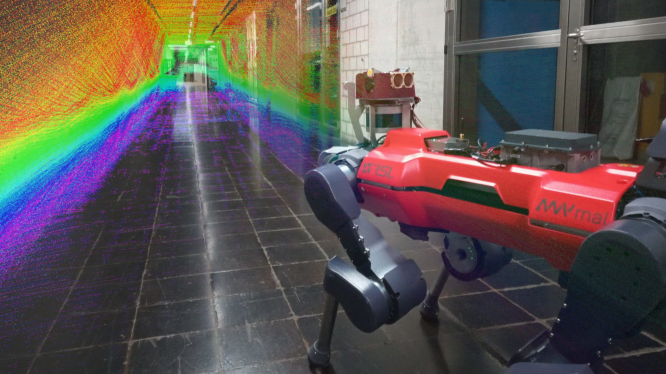This is the corresponding code to the above paper ("Self-supervised Learning of LiDAR Odometry for Robotic Applications") which is published at the International Conference on Robotics and Automation (ICRA) 2021. The code is provided by the Robotics Systems Lab at ETH Zurich, Switzerland.
Authors: Julian Nubert (julian.nubert@mavt.ethz.ch) , Shehryar Khattak , Marco Hutter
Copyright IEEE
We provide a conda environment for running our code.
The conda environment is very comfortable to use in combination with PyTorch because only NVidia drivers are needed. The Installation of suitable CUDA and CUDNN libraries is all handle by Conda.
- Install conda: link
- To set up the conda environment run the following command:
conda env create -f conda/DeLORA-py3.9.ymlThis installs an environment including GPU-enabled PyTorch, including any needed CUDA and cuDNN dependencies.
- Activate the environment:
conda activate DeLORA-py3.9- Install the package to set all paths correctly:
pip3 install -e .For running ROS code in the ./src/ros_utils/ folder you need to have ROS installed (link). We recommend Ubuntu 20.04 and ROS Noetic due to its native Python3 support. For performing inference in Python2.7, convert your PyTorch model with ./scripts/convert_pytorch_models.py and run an older PyTorch version (<1.3).
In any case you need to install ros-numpy if you want to make use of the provided rosnode:
sudo apt install ros-<distro>-ros-numpyInstructions on how to use and preprocess the datasets can be found in the ./datasets/ folder. We provide scripts for doing the preprocessing for:
- general rosbags containing LiDAR scans,
- and for the KITTI dataset in its own format.
Download the "velodyne laster data" from the official KITTI odometry evaluation (
80GB): link. Put it to <delora_ws>/datasets/kitti,
where kitti contains /data_odometry_velodyne/dataset/sequences/00..21.
Please also download the groundtruth poses here. Make sure
that the files are located at <delora_ws>/datasets/kitti, where kitti
contains /data_odometry_poses/dataset/poses/00..10.txt.
In the file ./config/deployment_options.yaml make sure to set datasets: ["kitti"]. Then run
preprocess_data.pyIf you want to add an own dataset please add its sensor specifications to ./config/config_datasets.yaml. Information that needs to be added is the dataset name, its sequences and its sensor specifications such as vertical field of view and number of rings.
After preprocessing, for each dataset we assume the following hierarchical structure:
dataset_name/sequence/scan (see previous dataset example). Our code natively supports training and/or testing on
various datasets with various sequences at the same time.
Run the training with the following command:
run_training.pyThe training will be executed for the dataset(s) specified in ./config/deployment_options.yaml. You will be prompted to enter a name for this training run, which will be used for reference in the MLFlow logging.
For custom settings and hyper-parameters please have a look in ./config/.
By default loading from RAM is disabled. If you have enough memory, enable it in ./config/deployment_options.yaml. When loading from disk, the first few iterations are sometimes slow due to I/O, but it should accelerate quite quickly. For storing the KITTI training set entirely in memory, roughly 50GB of RAM are required.
For continuing training provide the --checkpoint flag with a path to the model checkpoint to the script above.
For visualizing progress we use MLFlow. It allows for simple logging of parameters, metrics, images, and artifacts. Artifacts could e.g. also be whole TensorBoard logfiles. To visualize the training progress execute (from DeLORA folder):
mlflow ui The MLFlow can then be visualized in your browser following the link in the terminal.
Testing can be run along the line:
run_testing.py --checkpoint <path_to_checkpoint>The checkpoint can be found in MLFlow after training. It runs testing for the dataset specified in ./config/deployment_options.yaml.
We provide an exemplary trained model in ./checkpoints/kitti_example.pth.
This ROS-node takes the pretrained model at location <model_location> and performs inference; i.e. it predicts and
publishes the relative transformation between incoming point cloud scans. The variable <dataset> should contain
the name of the dataset in the config files, e.g. kitti, in order to load the corresponding parameters. Topic and frame
names can be specified in the following way:
run_rosnode.py --checkpoint <model_location> --dataset <dataset> --lidar_topic=<name_of_lidar_topic> --lidar_frame=<name_of_lidar_frame>The resulting odometry will be published as a nav_msgs.msg.Odometry message under the topic /delora/odometry
.
For the darpa dataset this could look as follows:
run_rosnode.py --checkpoint ~/Downloads/checkpoint_epoch_0.pth --dataset darpa --lidar_topic "/sherman/lidar_points" --lidar_frame sherman/ouster_linkAdditional functionalities are provided in ./bin/ and ./scripts/.
Located in ./bin/, see the readme-file ./dataset/README.md for more information.
After starting a roscore, conversion from KITTI dataset format to a rosbag can be done using the following command:
python scripts/convert_kitti_to_rosbag.pyThe point cloud scans will be contained in the topic "/velodyne_points", located in the frame velodyne. E.g.
for the created rosbag, our provided rosnode can be run using the following command:
run_rosnode.py --checkpoint ~/Downloads/checkpoint_epoch_30.pth --lidar_topic "/velodyne_points" --lidar_frame "velodyne"Converion of the new model <path_to_model>/model.pth to old (compatible with <
PyTorch1.3) <path_to_model>/model_py27.pth can be done with the following:
python scripts/convert_pytorch_models.py --checkpoint <path_to_model>/modelNote that there is no .pth ending in the script.
The execution time of the network can be timed using:
python scripts/time_network.pyThank you for citing DeLORA (ICRA-2021) if you use any of this code.
@inproceedings{nubert2021self,
title={Self-supervised Learning of LiDAR Odometry for Robotic Applications},
author={Nubert, Julian and Khattak, Shehryar and Hutter, Marco},
booktitle={IEEE International Conference on Robotics and Automation (ICRA)},
year={2021},
organization={IEEE}
}
Dependencies are specified in ./conda/DeLORA-py3.9.yml and ./pip/requirements.txt.
If the result does not achieve the desired performance, please have a look at the normal estimation, since the loss is usually dominated by the plane-to-plane loss, which is impacted by noisy normal estimates. For the results presented in the paper we picked some reasonable parameters without further fine-tuning, but we are convinced that less noisy normal estimates would lead to an even better convergence.
